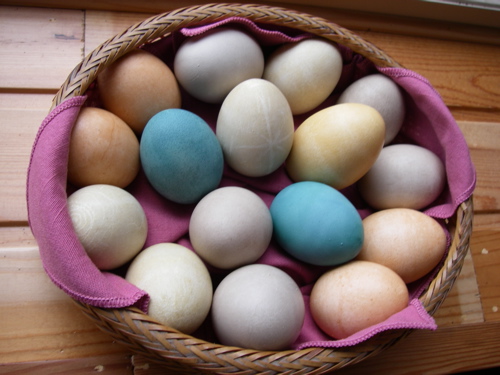It’s Easter Sunday. Among other celebratory activities, we’ll be hiding eggs for Aly to find, perhaps for the last time, as she’ll likely be away at college next year. As is our tradition, we’ll hide plastic eggs, holding back our real eggs to avoid the risk that ravens might steal them.
This year, like in 2007, we tried coloring our eggs with natural dyes. Going natural means settling for less vivid colors, generally, but the results can be quite beautiful.
This year, the natural dyes proved so disappointing that I won’t even include photos of them here. It’s really hard to wildcraft natural dyes in our region at this time of year. Plant life is just waking up. The available dye plants (alder and willow bark and ferns, for example) just don’t have their juices flowing yet. Many of the dye sources simply haven’t developed yet.
We discussed this, and hit upon a new strategy. We plan to blow eggs throughout the summer, and dye them as the sources become available. By next Easter, we should have a fine (though fragile) collection of decorative Easter eggs. That will likely offset next year’s dyeing session for the edible eggs.
Of course, the eggs we’re most interested in finding this year are herring eggs. The herring ought to arrive on our coast any day, if they’re not here already. It has been windy, so they might have moved into the area without us knowing.
This year, Easter Sunday coincides with Saint Mark’s Eve, the night before my namesake saint’s day. Traditionally, this is a night for divining. A young woman (such as Aly, say) who wished to know the identity of her future husband supposedly should fast after sunset, and bake a cake in the night. The cake must contain an eggshellful each of salt, wheat meal, and barley meal. She then opens the door of her home. Her future lover will supposedly come in and turn the cake. Or, if he really is her true love, one would hope that he would throw the darn thing out rather than risk letting anyone eating it!
If you’re reading Mary Oliver’s Twelve Moons with me, today’s the day to read her poem, The Black Snake, at least in my time zone. The last quarter moon might be tomorrow in your time zone.

